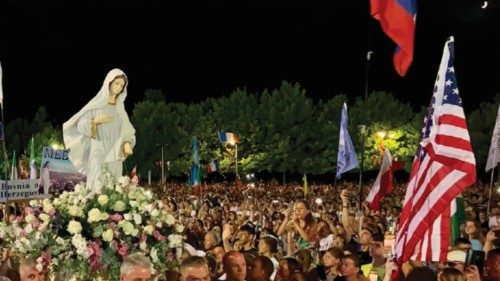
The official green light for the devotion and spiritual experience that began in Medjugorje in June 1981, when six children reported seeing Our Lady, was made possible thanks to the abundant positive fruits observed in the parish, which over 1 million people from around the world visit every year. These fruits include pilgrimages, conversions, people returning to the Sacraments, and troubled marriages that begin a path of healing.
These are the elements that Pope Francis has always observed, even when he was a bishop in Argentina, affirming that popular piety which moves so many people toward shrines must be accompanied, corrected when necessary, but not stifled.
When judging alleged supernatural phenomena, attention must always be paid to the spiritual fruits. This perspective of the Successor of Peter corresponds to new norms published in May that have detached the Church’s judgment from the more demanding recognition of a supernatural event. The latter may still come, but it is no longer necessary to wait for it to authorize liturgies, devotions, and pilgrimages, provided there are no deceptions or hidden interests, the messages are orthodox, and above all, many positive experiences are confirmed.
Thanks to Pope Francis’ heart of a shepherd, the pronouncement on one of the most well-known and controversial Marian apparitions of the last century has taken place. It is a decision that does not come as a surprise.
Already in May, Cardinal Fernández, responding to a question about Medjugorje, had said: “With these regulations, we think it will be easier to move forward and reach a conclusion.” This is not an unprecedented approach, as attested by the words used by then-Cardinal Ratzinger in the book-length interview, “The Ratzinger Report”: “One of our criteria is to separate the aspect of true or presumed ‘supernaturality’ of the apparition from that of its spiritual fruits. The pilgrimages of ancient Christianity were directed toward places about which our modern critical spirit might sometimes be perplexed as to the ‘scientific truth’ of the tradition linked to them. This does not mean that these pilgrimages were not fruitful, beneficial, important for the life of the Christian people. The problem is not so much that of the hyper-critical modern outlook (which ends up, among other things, in a form of new credulity) but that of evaluating the vitality and orthodoxy of the religious life that develops around these places.”
Pope Benedict xvi himself, in 2010, had set up a Commission led by Cardinal Ruini to study the phenomenon, and the outcome was favourable.
The Note, entitled “Queen of Peace,” thus recognizes the goodness of the fruits, presents an overall positive judgment of the numerous messages related to Medjugorje that have been disseminated over the years, correcting some problematic texts and some interpretations that may have been influenced by the subjective influence of the alleged visionaries.
Regarding the children who were protagonists of the phenomenon, who over the years were at the heart of controversies and even accusations, the document clarifies from the very first lines that the approval does not imply a judgment on their moral lives and that, in any case, spiritual gifts “do not imply a judgment about the moral life of the alleged visionaries.”
At the same time, the very fact that approval was granted signifies that no particularly critical or questionable aspects were detected, nor lies, fabrications, or mythomanias.
The Dicastery’s Note highlights the two central aspects of the Medjugorje message: that of conversion and return to God, and that of peace. When the phenomenon began and Mary appeared as the “Queen of Peace,” no one could have imagined that those very lands would be the theatre of bloody clashes during the Balkan war.
Participating in a pilgrimage, this reporter was deeply moved by the testimonies of friends and fellow citizens of the visionaries: people who were in no way involved in the apparitions or messages, who, faced with the cruelties of the war fought in those lands even among neighbours, had found a way to forgive.
Thanks to their experience of faith linked to the apparitions of Medjugorje, they had reconciled even with those who had committed grave acts of violence against their relatives. This represents a much more “miraculous” aspect than many other phenomena discussed around sites of the alleged apparitions.
The authentic message of Medjugorje ultimately lies in those messages in which Our Lady humbles herself and invites everyone not to follow false prophets, nor seek out news about “secrets” and apocalyptic predictions.
One message from November 1982 bears this out: “Do not go in search of extraordinary things. Instead, take the Gospel, read it, and everything will be clear to you.” (A. Tornielli)
By Andrea Tornielli













 Purchase the Encyclical here Fratelli Tutti
Purchase the Encyclical here Fratelli Tutti
